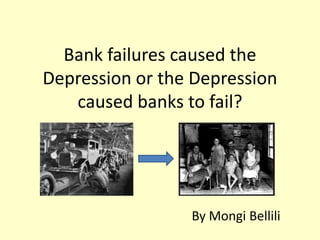Bank failures
- 1. Bank failures caused the Depression or the Depression caused banks to fail? By Mongi Bellili
- 2. Preview • The causes of bank failures. • The manifestations of the failure. • The effects of the banking system collapse.
- 3. The causes of bank failures 1. The market crash. 2. The people Consumerism was built on credit. In 1929, 6 billions of goods are bought on credit. 80% of Americans have no savings. Businesses could not repay their loans. depositors attempted to withdraw their deposits en masse.
- 4. The causes of bank failures 3. The government  Effects of money supply, and central banking decisions. No regulations and no insurance. The federal reserve bank gave little help. Ineffective use of the news. 4. The bankers: Involvement in the stock market. No backup money.
- 5. The causes of bank failures 5. Complexity: The liquidation of debt could not keep up with the fall of prices. The liquidation increased the value of each dollar owed, relative to the value of declining assets.
- 7. The manifestations of the failure 1. The number of failed banks: Throughout the 1930s over 9,000 banks failed. Surviving banks stopped providing loans.
- 8. The manifestations of the failure 1. The amount of money lost: By April 1933, around $7 billion in deposits had been frozen in failed banks. 2. The bank owners: Bankruptcy, debt and suicide
- 9. The effects of the failure 1. People: Panicked and stayed away from banks. Loss of confidence led to a reduction in consumption. Everyday, 1000 of homes are repossessed.
- 10. The effects of the failure 2. Economy: Debt deflation. the demand dropped. Unemployment.
- 11. Contents • The causes of bank failures. • The manifestations of the failure. • The effects of the banking system collapse.
- 12. Conclusion • A vicious cycle developed. • This self-aggravating process turned a 1930 recession into a 1933 great depression.












